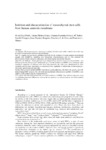Mostrar o rexistro simple do ítem
Isolation and characterization of mesenchymal stem cells from human amniotic membrane
| dc.contributor.author | Díaz-Prado, Silvia | |
| dc.contributor.author | Muíños-López, Emma | |
| dc.contributor.author | Hermida Gómez, Tamara | |
| dc.contributor.author | Rendal Vázquez, María Esther | |
| dc.contributor.author | Fuentes Boquete, Isaac Manuel | |
| dc.contributor.author | De-Toro, Javier | |
| dc.contributor.author | Blanco García, Francisco J | |
| dc.date.accessioned | 2016-05-13T07:06:44Z | |
| dc.date.available | 2016-05-13T07:06:44Z | |
| dc.date.issued | 2011-01-04 | |
| dc.identifier.citation | Díaz-Prado S, Muiños-López E, Hermida-Gómez T, Rendal-Vázquez ME, Fuentes-Boquete I, de Toro FJ, et al. Isolation and characterization of mesenchymal stem cells from human amniotic membrane. Tissue Eng Part C Methods. 2011;17(1):49-59. | es_ES |
| dc.identifier.uri | http://hdl.handle.net/2183/16666 | |
| dc.description.abstract | [Abstract] Introduction: The human amniotic membrane is a highly abundant and readily available tissue that may be useful for regenerative medicine and cell therapy. Aim: To compare two previously published protocols for the isolation of human amnion mesenchymal stromal cells (hAMSCs), including their phenotypic characterization and in vitro potential for differentiation toward osteogenic, adipogenic, and chondrogenic mesodermal lineages. Materials and Methods: Human placentas were obtained from selected caesarean-sectioned births. Two different protocols (Alviano et al.1 and Soncini et al.2) for the isolation of hAMSCs were performed. After monolayer expansion of adherent cells from both protocols, the cells were characterized by flow cytometry and for multi- potentiality, as assessed by their capability to differentiate toward adipocyte-, osteoblast-, and chondrocyte-like cells. Results: Both protocols yielded hAMSCs that showed plastic adherence, fibroblast-like growth, and well-defined human MSC markers. The cell yield and mesodermal differentiation capability of hAMSCs were higher in cells isolated using the Soncini protocol. Conclusions: Our data demonstrated the successful isolation of hAMSCs from full-term placentas using two published protocols. Differences between the two protocols in cell yield and in vitro differentiation potential are shown. | es_ES |
| dc.description.sponsorship | This study was supported by grants from Servizo Galego de Saúde, Xunta de Galicia (PS07/84), Catedra Bioiberica de la Universidade da Coruña and Instituto de Salud Carlos III CIBER BBN CB06-01-0040. Silvia Diaz-Prado holds an Isidro Parga Pondal contract from Xunta de Galicia, A Coruna, Spain. Tamara Hermida-Gómez holds a contract from Fondo de Investigación Sanitaria (2008), Spain. Emma Muíños-López is supported by the Rheumatology Spanish Foundation, Spain. We thank M.J. Sánchez and P. Filgueira for technical assistance | es_ES |
| dc.description.sponsorship | Instituto de Salud Carlos III; CB06-01-0040 | es_ES |
| dc.description.sponsorship | Xunta de Galicia; PS07/84 | |
| dc.language.iso | eng | es_ES |
| dc.publisher | Mary Ann Liebert | es_ES |
| dc.relation.uri | http://dx.doi.org/10.1089/ten.tec.2010.0136 | es_ES |
| dc.rights | Final publication is avaliable from Mary Ann Liebert, Inc., publishers. | es_ES |
| dc.title | Isolation and characterization of mesenchymal stem cells from human amniotic membrane | es_ES |
| dc.type | info:eu-repo/semantics/article | es_ES |
| dc.rights.access | info:eu-repo/semantics/openAccess | es_ES |
| UDC.journalTitle | Tissue Engineering Part C: Methods | es_ES |
| UDC.volume | 17 | es_ES |
| UDC.issue | 1 | es_ES |
| UDC.startPage | 49 | es_ES |
| UDC.endPage | 59 | es_ES |
Ficheiros no ítem
Este ítem aparece na(s) seguinte(s) colección(s)
-
GI-TCMR - Artigos [131]
-
INIBIC-TCMR - Artigos [102]
-
INIBIC- REUMA - Artigos [184]






